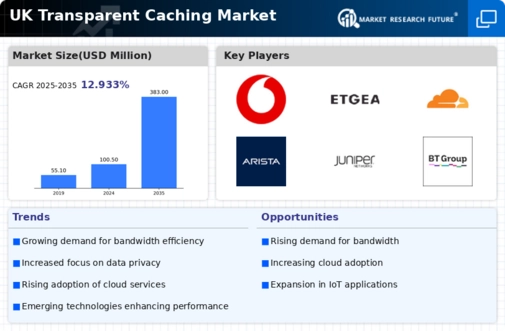Emergence of Edge Computing
The emergence of edge computing is significantly influencing the transparent caching market in the UK. As more data processing occurs closer to the source of data generation, the need for efficient data management solutions becomes paramount. Transparent caching technologies are well-suited to support edge computing by enabling faster access to frequently requested data, thereby reducing latency and improving overall system performance. The integration of transparent caching with edge computing architectures is expected to enhance the user experience, particularly in applications requiring real-time data processing. As the UK continues to embrace edge computing, it is likely to expand, driven by the demand for innovative solutions that facilitate efficient data handling.
Increased Focus on Cost Efficiency
Cost efficiency remains a pivotal driver in the transparent caching market, particularly as businesses in the UK strive to optimize their operational expenditures. By implementing transparent caching solutions, organizations can reduce the volume of data that needs to be transmitted over networks, leading to lower bandwidth costs. This is particularly relevant in an environment where data consumption continues to rise. Reports suggest that companies utilizing transparent caching can achieve savings of up to 25% on their data transfer expenses. As the competitive landscape intensifies, the transparent caching market is likely to benefit from businesses seeking innovative ways to enhance their cost structures while maintaining service quality.
Rising Adoption of Streaming Services
The transparent caching market is being propelled by the rising adoption of streaming services in the UK. With an increasing number of consumers subscribing to various streaming platforms, the demand for high-quality, uninterrupted content delivery has never been greater. Transparent caching solutions play a crucial role in optimizing bandwidth usage and ensuring that users experience minimal buffering and faster load times. Recent data indicates that the UK streaming market is expected to grow by over 20% annually, further emphasizing the need for effective caching strategies. As content providers seek to enhance user satisfaction and retention, the transparent caching market is likely to see significant investments aimed at improving service delivery and operational efficiency.
Regulatory Compliance and Data Sovereignty
Regulatory compliance and data sovereignty are increasingly shaping the landscape of the transparent caching market in the UK. With stringent data protection regulations in place, businesses are compelled to adopt solutions that ensure compliance while optimizing data management. Transparent caching can assist organizations in adhering to these regulations by providing localized data storage options, thereby mitigating risks associated with data transfer across borders. The UK market is witnessing a growing emphasis on data sovereignty, which is likely to drive the adoption of transparent caching solutions that align with regulatory requirements. As companies navigate the complexities of compliance, the transparent caching market is expected to see a rise in demand for solutions that facilitate secure and efficient data handling.
Growing Need for Enhanced Network Performance
there is a notable surge in demand due to the increasing need for enhanced network performance across various sectors in the UK. As businesses and consumers alike rely heavily on digital services, the pressure on network infrastructure intensifies. This has led to a growing recognition of transparent caching solutions, which can significantly reduce latency and improve data retrieval speeds. According to recent estimates, the adoption of transparent caching technologies could lead to a reduction in data transfer costs by up to 30%, thereby making it an attractive option for enterprises. Furthermore, as the UK continues to invest in its digital infrastructure, the transparent caching market is poised for substantial growth, driven by the necessity for efficient data management and seamless user experiences.























Leave a Comment